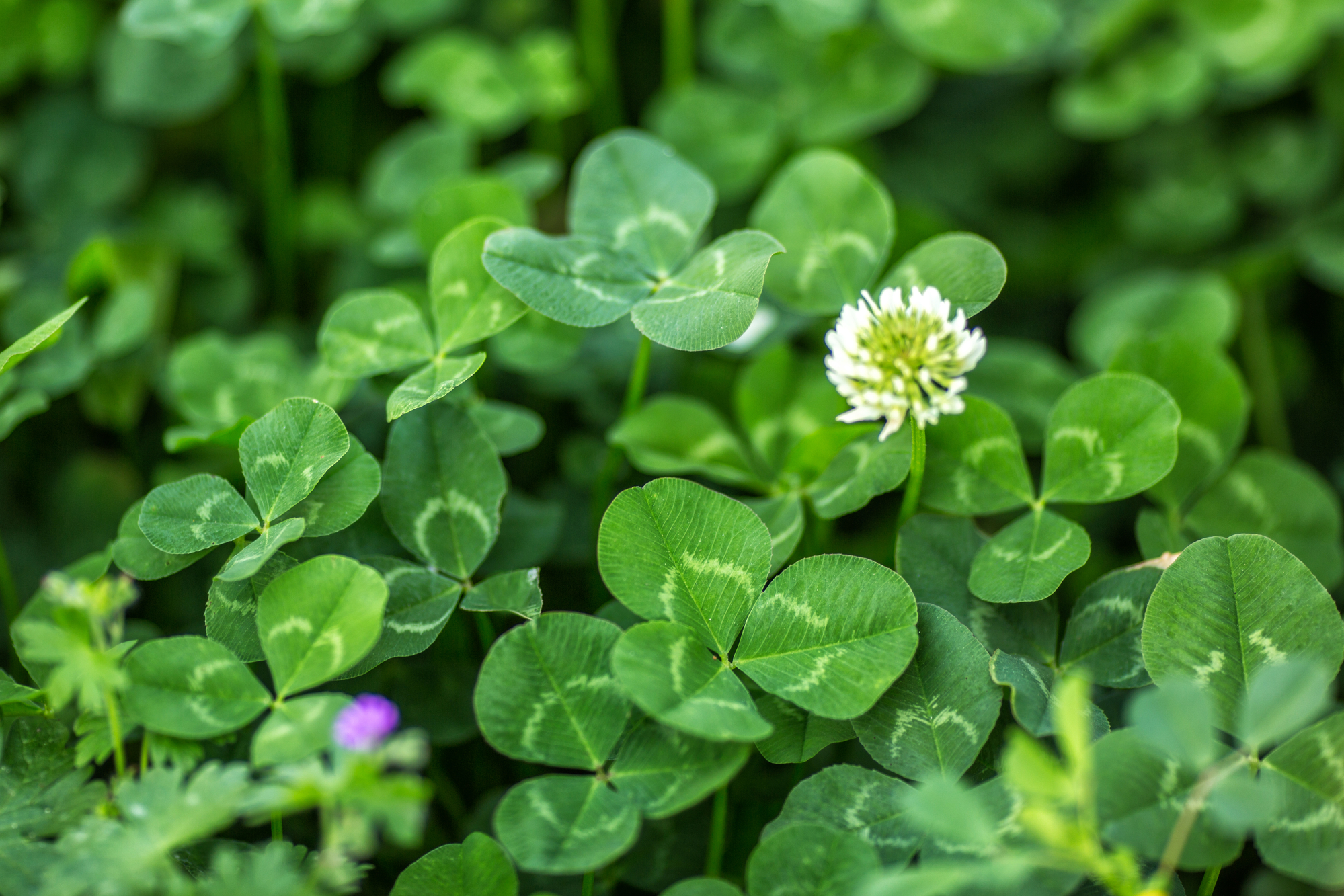Clover is a common sight in many lawns, and it often sparks debate among homeowners about whether it is a weed or a plant with hidden benefits. Clover can be both a nuisance weed and a beneficial ground cover, depending on your lawn goals and local conditions. Understanding its role is the first step to making the best choice for your garden.
Some people appreciate clover for its ability to improve soil and support pollinators, while others prefer to have a grass-only lawn. Knowing how to identify and assess clover in your own garden helps you decide if you want to control it or let it thrive.
Key Takeaways
- Clover can be considered a weed or a useful plant based on personal preference.
- There are both natural and chemical ways to manage clover in lawns.
- Preventing future clover growth depends on proper lawn maintenance and monitoring.
What Is Clover? Understanding Its Role in Lawns
Clover is a common ground cover found in many types of lawns. Its presence affects the appearance and health of turfgrass and is influenced by factors such as soil condition and maintenance habits.
Types of Clover Found in Lawns
The most frequently seen species in lawns is white clover (Trifolium repens).
Other common types include:
- Red clover (Trifolium pratense), which has taller growth and purple-pink flowers
- Microclover, a smaller-leaved variety of white clover bred for a lower profile
White clover is often favoured for its low growth habit and tolerance to mowing. Red clover is more likely to appear in uneven, less maintained areas due to its height and spreading nature. Microclover is sometimes included in lawn seed mixes because it blends more easily with turfgrass.
A simple comparison of clover types:
| Clover Type | Leaf Size | Flower Colour | Height |
|---|---|---|---|
| White clover | Medium | White | Low, spreading |
| Red clover | Larger | Purple-pink | Taller |
| Microclover | Very small | White | Very low |
Biological Characteristics of Clover
Clover is a perennial plant, regrowing each year from established root systems. It forms a mat-like ground cover and can spread rapidly by creeping stems called stolons.
The leaves are usually arranged in groups of three—hence the term “trifoliate.” Flowers appear as round heads and attract pollinators such as bees. Trifolium repens tolerates a wide range of soil types but prefers moist, fertile conditions. Its growth habit can help fill gaps in thinning turfgrass, reducing bare patches and soil erosion.
Clover maintains green colour even in dry summer weather because of its deeper root system compared to many lawn grasses. This resilience makes it a common sight in lawns that are not heavily fertilised or irrigated.
The Legume Family and Nitrogen Fixation
Clover belongs to the legume family (Fabaceae), meaning it can convert atmospheric nitrogen into forms usable by plants.
This process—known as nitrogen fixation—is possible due to a symbiotic relationship with Rhizobium bacteria in its root nodules. The bacteria change nitrogen from the air into ammonia, which clover and nearby plants can absorb and use for growth.
This unique ability allows clover to remain green and healthy even in nitrogen-poor soils. Its presence can actually reduce the need for fertiliser in a lawn by providing a natural supply of nitrogen for turfgrass and other ground cover species. For homeowners, this results in a potentially greener and more resilient lawn with fewer chemical inputs.
Is Clover a Weed or a Beneficial Plant?
Whether clover is unwanted or useful depends on lawn care goals and the local environment. It can present challenges for traditional lawns, but it also brings clear benefits for pollinator support and soil health.
Clover as a Weed: Arguments Against
Clover is often listed as a weed in weed control manuals and lawn care guides. This view is common among those who want a uniform green lawn without variation. Clover can stand out in established grass and spread quickly by creeping stems (stolons) and seed.
Standard weed killers for lawns usually target broadleaf plants, including clover, which leads some people to try to remove it. Concerns include its ability to crowd out popular turf grasses such as ryegrass and fescue.
Clover patches may create a patchwork look, disrupting the even appearance many homeowners desire. Those who compete in lawn competitions or value pristine turf tend to see clover as a nuisance rather than a feature.
Environmental Benefits of Clover
Clover, particularly white clover (Trifolium repens), improves soil health by fixing atmospheric nitrogen through its roots. This process reduces the need for synthetic fertilisers, saving money and limiting chemical runoff into waterways.
Its dense cover prevents soil erosion and helps retain moisture in the summer. Clover’s resilience often means less need for watering, which is beneficial during dry periods.
Clover’s presence increases soil fertility, making it easier to maintain a healthy lawn without heavy use of chemical treatments. Many gardeners incorporate clover into lawns as part of a natural approach to weed control and soil improvement.
Clover and Pollinators: Supporting Bees and Wildlife
Clover is highly valued for supporting pollinators such as bees. The plant produces clusters of small, nectar-rich flowers that provide food for honeybees, bumblebees, and other insects from spring through early autumn.
Healthy clover patches attract not only pollinators but also other forms of wildlife such as butterflies. By supplying nectar when many other lawn plants do not, clover helps sustain local bee populations.
Encouraging clover growth in lawns aids in wildlife conservation. Since many grass species offer little nectar, a lawn with clover supports a more active and diverse insect population. This can contribute to a balanced local ecosystem.
Identifying and Assessing Clover in Your Lawn
Clover is a common presence in lawns across the UK, but its impact depends on the type of grass species, maintenance methods, and desired lawn appearance. Identifying clover early helps in determining the right approach to manage or encourage its growth.
Recognising Clover Compared to Other Lawn Weeds
Clover, particularly white clover (Trifolium repens), stands out from other lawn weeds by its small, rounded, trifoliate leaf structure. Each leaflet often has a faint, pale crescent marking. Flowers are usually white or pinkish, clustered on short stalks.
Other common lawn weeds such as plantain, dandelion, or buttercup have distinctly different leaf shapes and flower forms. Dandelions show bright yellow composite flowers and jagged leaves, while plantain has flat, ribbed leaves with inconspicuous flower spikes.
A comparison table can help distinguish clover from others:
| Plant | Leaf Shape | Flower | Height |
|---|---|---|---|
| White Clover | 3 oval leaflets | White, ball | Low (2–8 cm) |
| Dandelion | Jagged, single | Yellow, single | Up to 30 cm |
| Plantain | Oval, ribbed | Small, spike | Low (up to 15 cm) |
| Buttercup | Lobed, shiny | Yellow, cup | Up to 40 cm |
Indicators of Clover Presence
Clover patches often signal thin, nutrient-poor areas in a lawn. It thrives where nitrogen is lacking, as it can fix its own nitrogen from the air, giving it an advantage over many grass species.
A common indicator includes small, green patches with dense, low-growing foliage and clusters of small white flowers. Grass around clover may appear paler or thinner.
Soil with compaction or regular mowing at low settings usually sees more clover infiltration. Lawns that receive fewer fertiliser applications or are watered infrequently may also show increased clover growth.
Clover Lawn vs. Thick Lawn
A clover lawn consists of clover-dominated turf, which stays green during dry spells, needs less fertiliser, and resists some pests. These lawns tend to have a softer texture and a dense mat of trifoliate leaves.
A thick lawn aims for dominance by grass species such as ryegrass or fescue. It gives a uniform look, is suitable for heavy foot traffic, and discourages most broadleaf weeds due to its tight canopy.
Differences:
- Maintenance: Clover lawns need less nitrogen; thick lawns require regular fertilising and mowing.
- Appearance: Clover lawns have white flower heads and patchy leaf clusters. Thick lawns are even and deep green.
- Tolerance: Clover tolerates drought and poor soil, while thick lawns may thin out under stress.
Choosing between a clover-rich or grass-dense lawn depends on personal preference, purpose, and maintenance capability.
Natural Methods to Control or Embrace Clover
Natural methods to get rid of clover or decide whether to keep it focus on grass health, correct mowing techniques, and safe options such as corn gluten meal or a homemade weed killer. Each approach offers safe and practical ways for different lawn preferences or concerns.
Encouraging Healthy Grass Growth
Strengthening grass growth helps remove clover by making it harder for clover to establish itself. Regular overseeding with appropriate grass seed fills bare areas where clover often invades. Maintaining proper soil nutrition, particularly nitrogen, assists grass in outcompeting clover, as clover thrives in nitrogen-poor soils.
Test soil pH annually and correct it to stay between 6.0 and 7.0. Apply a balanced fertiliser in spring and autumn, focusing on slow-release products to avoid surges in growth that stress the lawn. Water deeply, but not too often, to promote deep root systems for grass, limiting clover encroachment. A healthy, dense grass sward naturally shades out clover and other broadleaf species.
Adjusting Mowing Height and Lawn Maintenance
Mowing height plays an important part in clover and grass balance. Set the mower’s height between 7.5 cm (3 inches) and 9 cm (3.5 inches). Longer grass shades clover seedlings, reducing their establishment and spread.
Do not remove more than a third of the grass blade length at once, to avoid weakening the turf. Keep the mower blades sharp, as clean cuts reduce plant stress and lower the chance of disease. Regularly remove grass clippings when clover is flowering, as this practice can slow clover seed spread.
Edge and tidy lawn borders to avoid clover migration from adjacent areas. Routine raking, especially in early spring, lifts horizontal clover runners, making manual removal simpler.
Using Corn Gluten Meal and Homemade Weed Killers
Corn gluten meal, a by-product of maize processing, acts as a pre-emergent method to get rid of clover seeds before they germinate. Spread 2–3 kg per 100 square metres in early spring. Water lightly after application, but avoid heavy watering for a few days to activate its effects.
Homemade weed killer options include a mix of white vinegar and a few drops of washing-up liquid, sprayed carefully onto visible clover patches. Only treat patches directly, as vinegar can damage grass as well as clover. Avoid overuse to reduce the risk of harming desired plants.
Manual removal with a hand tool or a small fork is suitable for isolated patches and helps maintain lawn appearance. Consistent application of these methods can reduce clover without relying on chemical herbicides.
Chemical Approaches: Herbicides for Clover Control
Chemical options to address clover in lawns often rely on selective and broadleaf herbicides that target clover without harming most turf grasses. Mecoprop and dicamba are common active ingredients used in these products, offering varying strengths and application instructions.
Choosing the Right Selective Herbicide
Selecting an appropriate selective herbicide is important for targeting clover without damaging the surrounding grass. Most products designed for lawn use are formulated to avoid injuring common turf species like ryegrass and fescue.
Key ingredients often include mecoprop, dicamba, and sometimes 2,4-D. These herbicides attack broadleaf weeds, including clover, by disrupting their growth cycles.
When purchasing a weed killer, check labels to ensure it lists clover as a target species. Consumer products will also note if the formula is suitable for the specific grass types present. Failure to choose a selective product can result in harm to the entire lawn.
Application of Broadleaf Herbicides
Broadleaf herbicides are widely used against clover, as they mainly affect plants with broad leaves while sparing most grasses. These products may come as liquids for spray application or as granules for spreading.
Best results are achieved by applying when the clover is actively growing, usually during mild temperatures in spring or early autumn. Always follow the manufacturer’s instructions on dosage, timing, and intervals to avoid over-application or turf stress.
To improve effectiveness:
- Mow the lawn a few days before applying.
- Apply to damp foliage but avoid rainfall or irrigation for at least 6 hours after use.
- Repeat applications may be needed for stubborn infestations.
Understanding Mecoprop and Dicamba
Mecoprop and dicamba are both active substances frequently found in commercial clover control products. Each has a distinct mechanism:
Mecoprop acts by mimicking plant hormones, causing abnormal growth that eventually kills the weed. It is often combined with other herbicides for enhanced effect, especially against tougher clover varieties.
Dicamba disrupts cell division in broadleaf plants. It is systemic, which means it travels through the entire plant, helping to eliminate roots as well as above-ground parts.
Both substances require careful application. Overuse can drift to non-target plants and neighbouring gardens. Always wear gloves and avoid applying near edible crops or ornamental beds.
Preventing Future Clover Infestations
Regular, proper lawn maintenance plays a significant role in keeping clover from taking over. Strengthening turfgrass and practising correct care habits are key to reducing the chance of clover returning.
Lawn Care Habits to Deter Clover
Mowing at the correct height prevents clover from getting the sunlight it needs to spread. Most grass species benefit from being cut at 6-8 cm, which helps shade the soil and reduces opportunities for clover to germinate. Avoid mowing too short, as this weakens the grass and encourages weed growth.
Fertilise the lawn based on soil-test results. Clover often appears when nitrogen is low, since it can fix its own nitrogen. Use a balanced fertiliser according to recommendations for the chosen turfgrass and avoid over-fertilising, which can stress grass and open space for weeds.
Water deeply but infrequently. Shallow, frequent watering encourages weeds, including clover, while deep watering promotes stronger grass roots. Remove clippings from lawns mowed during heavy clover infestations to limit seed spread.
Checklist for Preventing Clover:
- Maintain proper mowing height
- Fertilise as recommended for grass type
- Water deeply, less often
- Remove clippings when clover is present
Building a Resilient Turfgrass System
Select grass species suited to the local climate and soil conditions to outcompete clover. For example, ryegrass or fine fescues perform well in cooler regions, while Bermuda or kikuyu may suit hotter areas. Overseeding thin areas each autumn or spring helps maintain thick turf that leaves little space for weeds.
Aerate compacted soil at least once a year. Compacted soil restricts root growth and gives an advantage to low-growing weeds like clover. Use a core aerator for best results. Repair bare spots promptly by reseeding or patching with turf.
Encourage healthy soil biology by leaving grass clippings (when clover isn’t present) to decompose, or applying light top-dressings of compost. This improves soil structure and nutrient cycling, making it easier for desirable turfgrass to thrive. Regular monitoring for early signs of clover allows quick corrective action before it spreads.
Clover Lawns: Weighing the Pros and Cons
Clover lawns provide benefits such as improved soil health and support for pollinators but may differ from traditional grass in appearance. The type of clover used and aesthetic preferences shape their suitability for various gardens.
Microclover as an Alternative Lawn Option
Microclover is a small-leaved variety of white clover (Trifolium repens) often blended with turfgrass species. It remains shorter than standard clover, creating a low, even lawn surface. Microclover helps fix nitrogen in the soil through a symbiotic relationship with certain bacteria, reducing the need for chemical fertilisers.
In dry periods, microclover maintains its colour better than common grass and shows good resilience to foot traffic. Its roots can improve soil structure, enhancing water infiltration and reducing compaction. On the other hand, microclover lawns may need reseeding every few years because clover plants have a shorter lifespan than most turfgrasses.
It can increase biodiversity at a microscopic and insect level. Yet, some people find regular clover too patchy or untidy, especially when it flowers and attracts bees. Microclover often produces fewer and less noticeable flowers than typical clover, which may help to address this concern.
Balancing Aesthetics and Biodiversity
Clover attracts bees, butterflies, and other pollinators, providing important food sources for wildlife. In gardens with a focus on supporting biodiversity, allowing clover to flower will benefit insects, birds and soil organisms.
There are certain trade-offs. Some prefer a uniform green surface, while a clover lawn sometimes introduces uneven colour or seasonal blooms. To help readers compare, here is a table summarising key points:
| Feature | Clover Lawn | Pure Grass Lawn |
|---|---|---|
| Supports pollinators | Yes | No |
| Drought resistance | Moderate-High | Low-Moderate |
| Mowing frequency | Less often | More often |
| Appearance | Patchy, variable | Even, uniform |
Choosing clover supports wildlife and reduces fertiliser use, but those looking for a classic grass appearance may find it less suitable. Children and pets playing in flowering clover may come into contact with bees, which is worth considering for family spaces.
Managing Clover in Relation to Invasive Species
Clover often appears alongside invasive species, which can make proper identification and control more challenging. Recognising the differences and using targeted weed control measures can help preserve clover where desired, while managing unwanted ground cover.
Distinguishing Clover from Other Invasives
Clover is sometimes misidentified as an invasive weed, but it differs from many true invasives in several key features. White clover (Trifolium repens) has three rounded leaflets, often with a pale crescent mark and small, white or pinkish flower heads. In contrast, invasive ground covers like creeping buttercup or knotweed feature different leaf shapes and growth patterns.
A simple table summarising some differences:
| Feature | Clover | Common Invasive Species |
|---|---|---|
| Leaf structure | 3 round leaflets | Varied, often more jagged |
| Flower | White/pinkish, small | Yellow (buttercup), often larger |
| Root system | Shallow, fibrous | Deep taproots or rhizomes |
Identifying clover correctly helps avoid unnecessary removal when pursuing weed control. Many invasives spread more aggressively and out-compete desirable grasses and plants, whereas clover often supports soil health.
Best Practices to Prevent Invasive Spread
Regularly inspect the lawn for new or unusual plants, as early detection of invasive species supports more manageable control. Clover does not generally spread in the same manner as more aggressive invasives, and keeping lawn grasses healthy can help it compete effectively.
Use targeted methods to control unwanted ground cover, such as hand-pulling or applying selective herbicides only where invasives are found. Mowing regularly and maintaining appropriate soil fertility reduces opportunities for invasive species to establish without harming beneficial clover.
Focus on a specific weed control plan by:
- Removing invasive plants before they flower
- Avoiding blanket herbicide applications that can damage clover and grass
- Monitoring edges and shady areas where invasives often appear first
Proper identification and intervention help maintain a lawn with a healthy balance of grass and clover, reducing the risk of invasive species dominating the ground cover.





